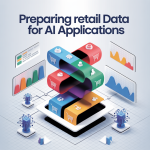AI in Visual Merchandising: Boosting Retail Impact with Smart Technology
Ideal for: Visual merchandisers, retail operations managers, marketing teams, store planners, and retail executives
Workshop Objectives:
-
Understand the role of AI in modern visual merchandising
-
Learn how AI tools analyze data to enhance display decisions
-
Explore real-world case studies where AI improved merchandising outcomes
-
Practice applying AI-powered insights to visual merchandising scenarios
-
Develop a plan to begin integrating AI into your merchandising strategy
Session Outline:
1. Welcome & Introductions (15 mins)
-
Overview of workshop goals
-
Participant introductions & poll: current challenges in visual merchandising
2. The Evolution of Visual Merchandising (20 mins)
-
Traditional methods vs. AI-enhanced approaches
-
Limitations of manual merchandising
-
Why now? Trends driving AI adoption in retail
3. Understanding AI in Retail Context (30 mins)
-
Key AI concepts (machine learning, computer vision, predictive analytics)
-
Retail-specific applications: planogram generation, demand prediction, customer journey mapping
4. AI Tools & Technologies for Merchandising (30 mins)
-
Overview of current solutions:
-
Shelf-scanning & compliance tools (e.g., Trax, Pensa)
-
Planogram optimization engines
-
Heatmap and footfall analysis systems
-
-
Live or video demo (if possible)
Break (15 mins)
5. Case Studies: AI in Action (30 mins)
-
Short examples from grocery, fashion, big box retail
-
Highlight impact on sales, labor efficiency, customer experience
6. Interactive Exercise: Merchandising Makeover (40 mins)
Participants work in small groups on a mock store layout.
-
Given: sales data, heatmaps, seasonal factors
-
Task: Apply AI-driven insights to propose a new display plan
-
Share back: Discuss differences vs. traditional approaches
7. Barriers & Breakthroughs (20 mins)
-
Common challenges in adopting AI: cost, training, integration
-
How to overcome resistance & build internal support
-
Low-cost ways to start with AI today
8. Action Planning & Next Steps (20 mins)
-
Worksheet: Where could AI make the biggest impact in your role?
-
Identify 1–2 concrete next steps
-
Q&A and resource round-up
Takeaways for Participants:
-
AI tool comparison guide
-
AI-in-merchandising implementation checklist
-
PDF slides and curated resource list
-
Certificate of participation (optional)
Current Challenges in Visual Merchandising
🔹 1. Inconsistent Execution Across Locations
-
Stores often struggle to implement visual standards consistently, especially in multi-location chains.
-
Planograms may be ignored, misinterpreted, or poorly executed by undertrained staff.
🔹 2. Lack of Real-Time Data
-
Many merchandising decisions are based on outdated or incomplete data.
-
Retailers can’t quickly adjust displays to respond to real-time trends, weather, or foot traffic changes.
🔹 3. Labor Shortages & Time Constraints
-
Visual merchandising is time-intensive, and retail teams are stretched thin.
-
There’s limited time for staff to refresh displays frequently or creatively.
🔹 4. Disconnect Between Merchandising and Customer Behavior
-
Traditional visual decisions are often made by gut instinct rather than behavioral insights.
-
Without customer data, displays may fail to attract attention or drive conversion.
🔹 5. Difficulty Measuring Impact
-
It’s hard to prove ROI from merchandising efforts.
-
Without reliable analytics, visual teams can’t justify time, budget, or innovation.
🔹 6. Rapidly Changing Consumer Preferences
-
Trends shift quickly, especially in fashion, beauty, and seasonal retail.
-
Static displays or slow update cycles result in missed opportunities.
🔹 7. Supply Chain Volatility
-
Delays and shortages lead to missing items in displays.
-
Visual plans need flexibility to accommodate substitutions or inventory gaps.
🔹 8. Digital vs. Physical Integration
-
Creating cohesive experiences between online and in-store visuals is challenging.
-
Omnichannel customers expect consistency, which requires better coordination.
🔹 9. Sustainability Pressure
-
Wasteful display materials and constant refreshes are under scrutiny.
-
Retailers must find eco-conscious ways to maintain visual appeal.
🔹 10. Limited Use of Technology
-
Many retailers still rely on manual methods for layout design, compliance checks, and performance tracking.
-
There’s hesitation or lack of knowledge about adopting AI, computer vision, or heatmapping tools.


